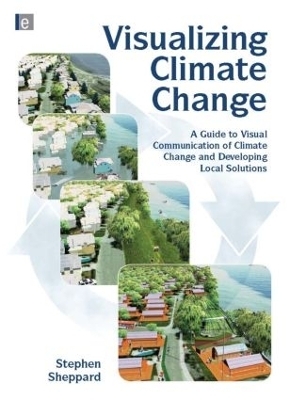
Visualizing Climate Change
Earthscan Ltd (Verlag)
978-1-84407-820-2 (ISBN)
- Titel z.Zt. nicht lieferbar
- Versandkostenfrei innerhalb Deutschlands
- Auch auf Rechnung
- Verfügbarkeit in der Filiale vor Ort prüfen
- Artikel merken
Carbon dioxide and global climate change are largely invisible, and the prevailing imagery of climate change is often remote (such as ice floes melting) or abstract and scientific (charts and global temperature maps).
Using dramatic visual imagery such as 3D and 4D visualizations of future landscapes, community mapping, and iconic photographs, this book demonstrates new ways to make carbon and climate change visible where we care the most, in our own backyards and local communities. Extensive color imagery explains how climate change works where we live, and reveals how we often conceal, misinterpret, or overlook the evidence of climate change impacts and our carbon usage that causes them.
This guide to using visual media in communicating climate change vividly brings to life both the science and the practical solutions for climate change, such as local renewable energy and flood protection. It introduces powerful new visual tools (from outdoor signs to video-games) for communities, action groups, planners, and other experts to use in engaging the public, building awareness and accelerating action on the world’s greatest crisis.
Stephen R.J. Sheppard is Professor in Landscape Architecture and Forest Resources Management at the University of British Columbia, Vancouver, and Director of the Collaborative for Advanced Landscape Planning (CALP). He is an internationally recognized expert in visualization, and has over 30 years’ experience in research and practice in landscape planning, public involvement, environmental perception, and, since 2003, in planning for climate change. He is a Fellow at the Institute for Sustainability Solutions Research, University of Plymouth, UK, and Adjunct Professor at the Nanjing Forestry University, China.
Preface. Foreword. Part 1: Setting the Scene on Climate Change 1. An Invisible Truth? Perceptions and Misperceptions of Climate Change 2. Limited Vision: Understanding Perceptual Problems with Climate Change 3. A New Climate Change Lens: Principles for Shifting Perceptions of Climate Change 4. Learning to See: Reframing Community Perceptions of Carbon and Climate Change Part 2: Knowing, Seeing, and Acting on Community Carbon & Climate Change 5. Right Before Our Eyes: Seeing Carbon 6. Hot in My Backyard: Seeing the Impacts of Climate Change 7. Cutting the Carbon: Seeing Mitigation Solutions to Climate Change 8. Being Prepared: Seeing Adaptation Solutions to Climate Change 9. Seeing the Big Picture on Community Carbon and Climate Change Part 3: Switching Lenses: Changing Minds with Visual Learning Tools 10. Landscape Messaging: Making Climate Change More Visible In the Community 11. Visual Media: Knowing Climate Change When You See it in Pictures 12. The Modern Crystal Ball: Visualizing the Future with Climate Change 13. Local Climate Change Visioning: Enhanced Processes for Planning Community Futures Part 4: With New Eyes to See: What the Future Looks Like With Climate Change 14. Realizing Future Community Visions: Getting to Low-carbon, Attractive, Resilient Communities Appendix: Code of Ethics for Landscape Visualization. List of Figures and Figure Credits. References. Index.
| Erscheint lt. Verlag | 29.3.2012 |
|---|---|
| Verlagsort | London |
| Sprache | englisch |
| Maße | 189 x 246 mm |
| Gewicht | 1440 g |
| Themenwelt | Geisteswissenschaften ► Psychologie ► Allgemeine Psychologie |
| Naturwissenschaften ► Biologie ► Ökologie / Naturschutz | |
| Naturwissenschaften ► Geowissenschaften ► Meteorologie / Klimatologie | |
| Technik ► Architektur | |
| Technik ► Bauwesen | |
| Technik ► Elektrotechnik / Energietechnik | |
| ISBN-10 | 1-84407-820-5 / 1844078205 |
| ISBN-13 | 978-1-84407-820-2 / 9781844078202 |
| Zustand | Neuware |
| Informationen gemäß Produktsicherheitsverordnung (GPSR) | |
| Haben Sie eine Frage zum Produkt? |
aus dem Bereich


